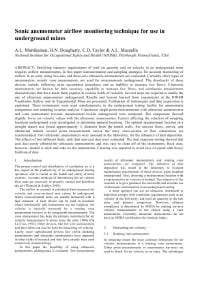Mining Publication: Sonic Anemometer Airflow Monitoring Technique for Use in Underground Mines
Original creation date: June 2010
Authors: AL Martikainen, HN Dougherty, CD Taylor, AL Mazzella
NIOSHTIC2 Number: 20036994
Proceedings of the 13th U.S./North American Mine Ventilation Symposium, Sudbury, Ontario, Canada, June 13-16, 2010. Hardcastle, McKinnon, eds., Sudbury, Ontario, Canada: MIRARCO - Mining Innovation, 2010; :217-224
Satisfying statutory requirements of total air quantity and air velocity in an underground mine requires airflow measurements. In this paper instrumentation and sampling strategies for accurate monitoring of airflow in an entry using two-axis and three-axis ultrasonic anemometers are evaluated. Currently other types of anemometers, mainly vane anemometers, are used for measurements underground. The drawbacks of these devices include following strict operational procedures and an inability to measure low flows. Ultrasonic anemometers are known for their accuracy, capability to measure low flows, and continuous measurement characteristics that have made them popular in various fields of research. Several steps are required to enable the use of ultrasonic anemometers underground. Results and lessons learned from experiments at the NIOSH Ventilation Gallery and its Experimental Mine are presented. Calibration of instruments and data acquisition is explained. Three instruments were used simultaneously in the underground testing facility for anemometer comparison and sampling location analysis. Continuous single-point measurements with ultrasonic anemometers and vane anemometer traverse measurement results underground were compared. The comparison showed slightly lower air velocity values with the ultrasonic anemometers. Factors affecting the selection of sampling locations underground were investigated to determine optimal locations. The optimal measurement location in a straight tunnel was found approximately 1/4 diameter from the tunnel walls. For uneven flows, curves, and obstructed tunnels several point measurements across the entry cross-section or flow simulations are recommended. Two ultrasonic anemometers were assessed in the laboratory, for the influence of dust deposition. The effects of two different dusts, rock dust and coal dust were evaluated. The dust exposure testing showed that coal dust rarely affected the ultrasonic anemometers and was easy to clean off of the instruments. Rock dust, however, tended to stick and cake on the instruments. Cleaning was required to avoid loss of signal with heavy build-up of dust.

NIOSHTIC2 Number: 20036994
Proceedings of the 13th U.S./North American Mine Ventilation Symposium, Sudbury, Ontario, Canada, June 13-16, 2010. Hardcastle, McKinnon, eds., Sudbury, Ontario, Canada: MIRARCO - Mining Innovation, 2010; :217-224
- Cause of Floor Self-Heatings in an Underground Coal Mine
- Effects of Obstructions, Sample Size and Sample Rate on Ultrasonic Anemometer Measurements Underground
- Maximizing the Ventilation of Large-Opening Mines
- Measurement of Airflow in a Simulated Underground Mine Environment Using an Ultrasonic Anemometer
- Near Real Time Monitoring of Diesel Particulate Matter in Underground Mines
- Performance of a Light Scattering Dust Monitor at Various Air Velocities: Results of Sampling in the Active Versus the Passive Mode
- Rock Dusting Considerations in Underground Coal Mines
- Use of Vacutainers for Collection of Mine Atmosphere Samples
- Using Ultrasonic Anemometers to Evaluate Face Ventilation Conditions
- Using Ultrasonic Anemometers to Evaluate Factors Affecting Face Ventilation Effectiveness